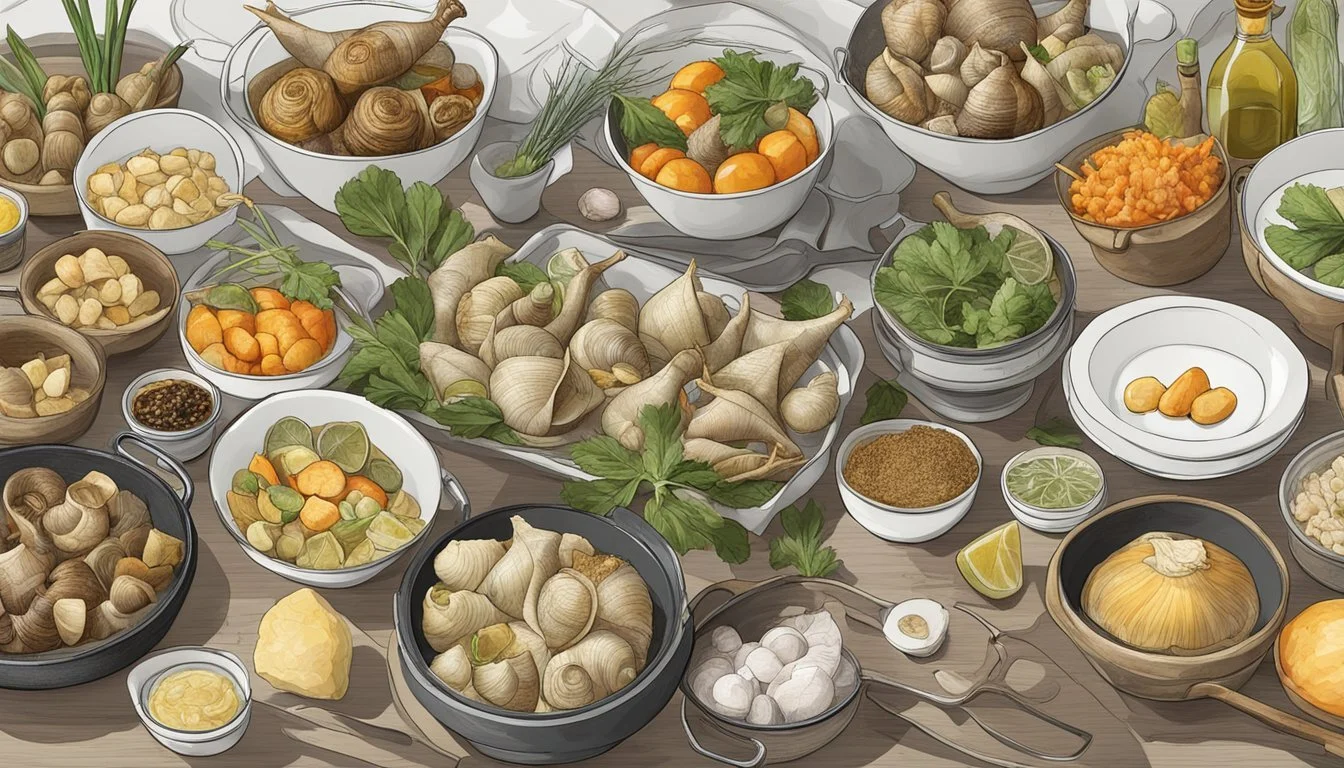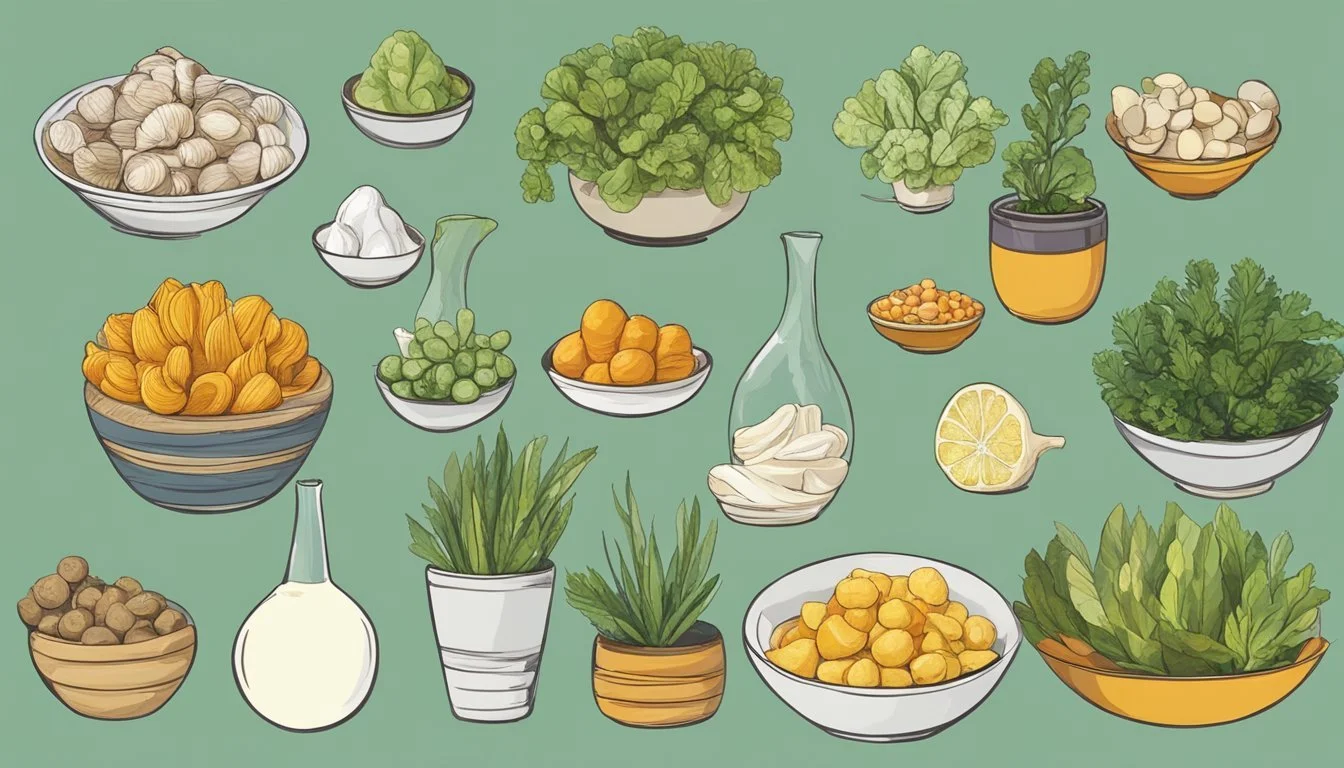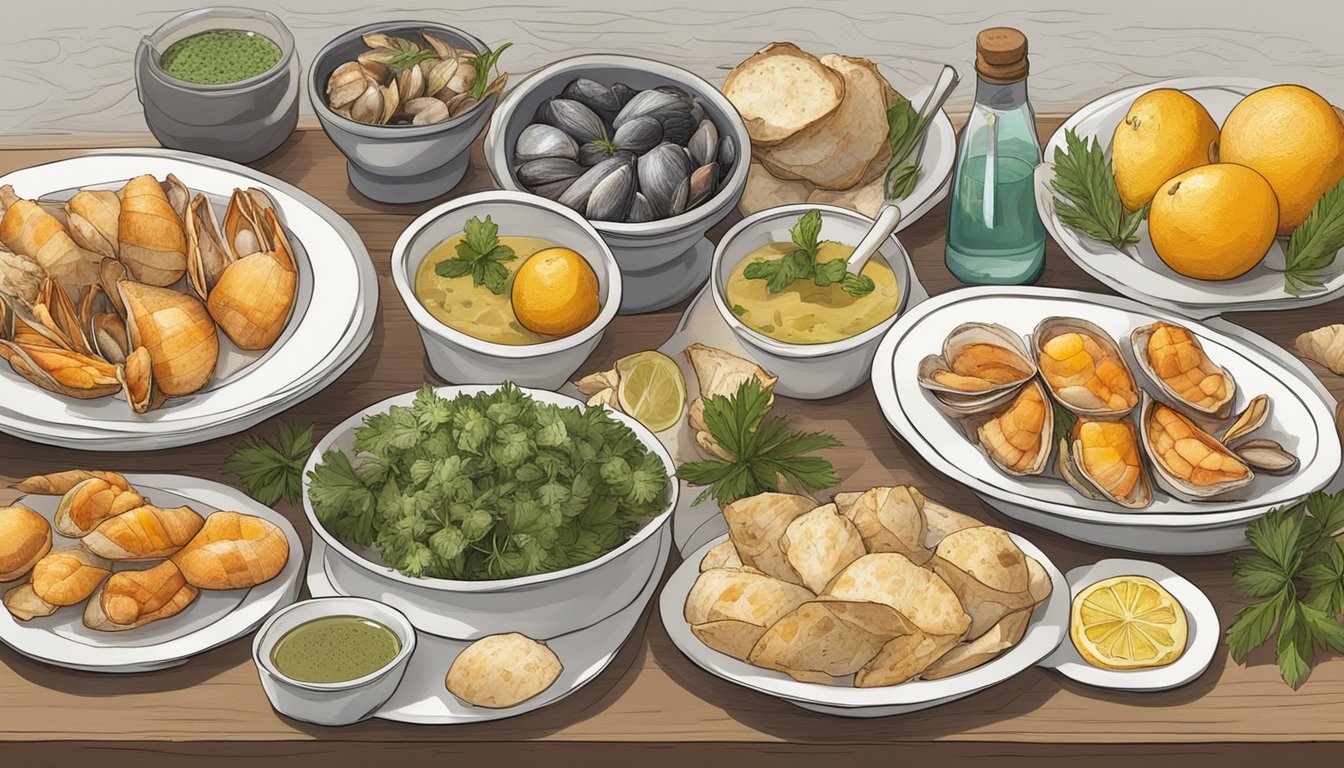Whelk Substitutes
Best Seafood Alternatives for Your Recipes
For those who love the tender and succulent taste of whelk, a type of sea snail from the family Buccinidae, sometimes finding this delicacy can be challenging. Whether it's due to local availability or personal preference, knowing suitable substitutes is essential. Clams, squid, oysters, and scallops all make excellent replacements for whelk in various dishes. Their textures and flavors can closely mimic those of whelk, ensuring your seafood platter or noodle dish remains delicious.
Whelks are marine gastropods with elegantly spiraled shells, popular across Europe and beyond. In Britain, they are a staple at seaside stands; in France, they feature prominently in seafood platters, while Italians often incorporate them into pasta dishes. When whelks are hard to come by, turning to clams or squid can provide similar culinary experiences, while oysters and scallops offer a different, yet equally delightful, taste.
One notable dish, spicy whelks with noodles (Golbaengi-muchim), perfectly showcases whelk's unique texture and flavor. If whelks aren't available, squid can be a fantastic substitute, maintaining the essential chewiness. For other recipes, the subtle taste of oysters or the slightly firm texture of scallops can easily stand in, ensuring you never have to miss out on enjoying your favorite seafood meals.
Understanding Whelks
Whelks are marine gastropods commonly found in various marine environments around the world. These mollusks are known for their unique spiral shells and significant nutritional benefits.
Biology and Habitat
Whelks are part of the marine gastropod family Buccinidae. They possess a distinctive spiral-shaped shell that varies in size and color. These shells can range from under an inch to over two feet in length, with the trumpet whelk being the largest species.
Whelks are predatory creatures relying on a radula, a toothed tongue-like structure, to feed on their prey. They are typically found in diverse marine environments, from shallow waters to deep sea ecosystems, thriving in habitats that range from tropical to temperate regions.
Nutritional Profile
Whelks are a nutritious source of protein and other essential nutrients. They are low in fat and calories, making them an excellent choice for those seeking a lean protein source. Each serving of whelk meat provides a significant amount of iron, which is vital for blood health and oxygen transport in the body.
These mollusks also offer other health benefits, including vitamins and minerals, contributing positively to overall diet and wellbeing. Incorporating whelks into meals can be a flavorful way to boost nutritional intake.
Global Varieties
Various species of whelks are found across the globe, each with unique characteristics. In North America, common varieties include the knobbed whelk and channeled whelk. These species are often found along the Eastern Seaboard and are prized for their culinary uses.
In Europe, different species such as the common whelk are popular, especially in coastal regions where they are harvested. The Far East also values whelks, integrating them into traditional dishes and cuisines. The numerous global varieties exemplify the adaptability and widespread appeal of this marine gastropod.
By understanding whelks, one gains insight into their ecological significance, health benefits, and the myriad ways they are enjoyed worldwide.
Culinary Uses of Whelks
Whelks are versatile seafood with various preparation techniques and applications in global cuisines. They can be boiled, grilled, or used in innovative recipes to add a briny flavor to dishes.
Classical Preparation Techniques
Boiling is a popular method for preparing whelks. Boiled whelks can be simmered in water until tender, then served with a butter dipping sauce. Removing the meat from the shells reveals its tender texture, suitable for immediate consumption or further cooking.
Grilling brings out a smoky flavor. Grilled whelks are usually placed directly on a hot grill for a few minutes. Another classic approach includes making fritters, where cooked whelk meat is mixed with batter and fried to golden perfection, adding a crispy texture.
Whelks in Global Cuisines
In France, whelks, known as bulots, are often served with aioli or in seafood stews. The UK enjoys them in seafood mixtures and as snacks. Known as scungilli in Italian cuisine, they appear in pasta dishes and salads, providing a unique twist to traditional recipes.
Japan has incorporated whelks into sushi, highlighting their briny flavor. Whelks' adaptability lends them well to a wide range of dishes, from simple snacks to sophisticated meals.
Innovative Whelk Recipes
Innovative cooking methods have expanded whelks' culinary uses. Whelk meat can be used in sushi rolls, adding an intriguing element with its chewy texture. Pasta dishes featuring whelk offer a delightful seafood twist.
Chefs have started incorporating whelks in modern recipes like seafood stews, where their distinct flavor enhances the overall dish. Experimenting with whelk recipes, such as including them in fritters or as a unique pizza topping, showcases their versatility.
Selecting and Preparing Whelks
Selecting and preparing whelks involves choosing fresh specimens, preparing them for cooking, and effectively cleaning and de-shelling them. Each step ensures that the whelks are safe and delicious for consumption.
Buying Fresh Whelks
When buying fresh whelks, look for ones that are firm with a tightly closed shell. This indicates they are alive and fresh. Avoid whelks with cracked or broken shells, as these could be indicators of spoilage.
Whelks should smell like the ocean and not have any fishy odor. Shells that are shiny and wet suggest the whelks have been kept in fresh seawater and are more likely to be fresh. If possible, buy whelks from a reputable fishmonger or seafood market.
Preparing for Cooking
Before cooking, it’s essential to prepare the whelks properly. Place them in a bowl of cold water and sprinkle with salt. Allow them to sit for a few hours — this helps to purge sand and grit from their systems.
Once purged, rinse the whelks thoroughly under cold running water. This step ensures that any remaining debris is removed. From here, they can be boiled, steamed, or stir-fried, depending on the recipe.
Cleaning and De-Shelling
To clean and de-shell whelks, start by boiling them in salted water for approximately 15 minutes. Remove the whelks from the water and let them cool slightly until they can be handled.
Using a small fork or a pick, carefully extract the meat from the shells. Remove the hard, disc-like operculum and the digestive tract, as these parts are not edible. Rinse the whelk meat under cool water to ensure it is thoroughly cleaned. The whelks are now ready to be used in various dishes.
Cooking Techniques for Whelks
Whelks can be prepared using various methods to bring out their unique flavor and firm texture. Boiling and simmering, grilling, and incorporating them into dishes are some of the most popular techniques.
Boiling and Simmering
Boiling and simmering whelks is a straightforward method that enhances their natural taste. Place the cleaned whelks into a pot of boiling water or court-bouillon (a flavorful broth made from water, wine, and aromatics like carrot, onion, celery, and sea salt).
Boil them for about 10-15 minutes until the shells open. Once cooked, remove them from their shells and they are ready to eat. The tender meat can be added to a variety of dishes or served simply with a squeeze of lemon.
Grilling and Sautéing
Grilling offers a smoky flavor to whelks, making it a favorite among seafood enthusiasts. Place the whelks directly on a hot grill and cook for a few minutes until the meat is done. Watch carefully to avoid overcooking, which can toughen the meat.
Sautéing can be done in a wok or skillet with a bit of oil. First, boil the whelks, remove the meat from the shells, and slice it. Sauté with garlic, herbs, and your choice of vegetables for a savory dish.
Incorporating Into Dishes
Whelks are versatile and can be included in various dishes. They can be sliced and added to stir-fry or pasta dishes. In stir-fries, whelk meat pairs well with vegetables like bell peppers, onions, and broccoli.
For a pasta dish, boil the whelks, extract the meat, and slice it. Toss the whelk meat with cooked pasta, olive oil, garlic, and herbs for a delightful seafood pasta. Whelks can also be served as appetizers, simply boiled with dipping sauces like garlic butter or aioli.
Sauces and Accompaniments
Choosing the right sauces and accompaniments can elevate the flavor profile of whelk dishes. This section explores two specific approaches to enhancing whelk with various seasonings and additions.
Butter and Garlic Combinations
Butter and garlic create a classic combination that enhances the natural flavors of whelk. Melting butter with minced garlic provides a rich, aromatic dipping sauce perfect for drizzling over cooked whelk. Adding a squeeze of fresh lemon juice can introduce a refreshing tang that balances the richness of the butter.
Flat-leaf parsley can be finely chopped and mixed into the butter garlic sauce for additional color and a mild herbal note. Crusty bread can accompany this buttery concoction, ideal for soaking up the flavorful juices. Seasonings like black pepper or a hint of chilli can offer a slight kick, adding complexity to the dish.
Herbs and Spices Enhancements
Using fresh herbs and a variety of spices can significantly elevate whelk dishes. Flat-leaf parsley, when finely chopped, introduces a bright, clean flavor that complements the marine taste of whelk. Black pepper, freshly ground, adds subtle heat.
Adding a mix of seasonings like chilli flakes or paprika can introduce a burst of spiciness, depending on the desired heat level. Lemon zest can impart a citrusy aroma without the acidity.
For those preferring a more aromatic profile, combining seasonings like crushed garlic with finely chopped parsley and black pepper can create an exquisite rub for whelk. Using dried or fresh herbs ensures a consistent flavor uplift.
Alternative Seafood Substitutes
Alternative seafood substitutes offer varied options that mimic the texture and flavor of traditional seafood, as well as specific shellfish varieties. This section focuses on popular plant-based and other substitute ingredients that can replace seafood and shellfish in diets.
For Texture and Flavor
Tofu is a versatile substitute due to its ability to absorb flavors and mimic the texture of various seafood. It's particularly useful in simulating the softness of scallops or the chewiness of prawns.
Banana Blossom has a flaky texture, making it a suitable replacement for fish fillets. When marinated properly, it can replicate the taste and mouthfeel of traditional seafood dishes.
Jackfruit is often used for its fibrous texture, which can imitate shellfish like conch and abalone. This substitute is excellent in recipes that require a tender, meat-like consistency.
Cauliflower is known for its ability to absorb flavors and provide a firm, yet tender, texture. It is commonly used to recreate vegan versions of fish steaks or scallops.
Seaweed and Oyster Sauce can enhance plant-based substitutes with an authentic seafood taste. These ingredients add umami and briny notes reminiscent of ocean flavors.
Shellfish Varieties
Periwinkles (also known as winkles) and clams can be simulated using mushrooms. The chewy texture and umami flavor of mushrooms make them suitable for recreating these shellfish varieties.
Tempeh can be transformed into crab cakes by combining it with appropriate spices and seasonings. This fermented soybean product can mimic the firmness and flaky texture of crab.
Plant-based shrimp, like those from New Wave or Sophie's Kitchen, provide a similar texture and flavor to traditional shrimp. These products often use natural plant ingredients to create an authentic shrimp experience.
Prawns and scallops can be replicated using textured soy protein or konjac root. These materials offer a similar chewiness and firmness, making them ideal for vegan seafood dishes.
Vegan seafood products from brands such as Gardein and Quorn offer ready-made options like mini crabless cakes and fish-less sticks. These products cater specifically to those looking to avoid traditional shellfish.
These alternatives provide a variety of options for those who seek the taste and texture of seafood without using actual seafood.
Storage and Preservation
Proper storage and preservation of whelks are crucial for maintaining their quality and extending their shelf life. Key methods include refrigeration for short-term storage and freezing for long-term preservation.
Refrigeration Best Practices
Whelks should be kept in the refrigerator if they will be consumed within a few days. Store live whelks in a cool environment, ideally at temperatures between 32°F and 40°F. It's recommended to place them in a bowl with a damp cloth over them to keep them moist.
If they have been cooked, place the whelk meat in an airtight container. This helps retain moisture and prevent the absorption of other odors. Generally, cooked whelk meat can be refrigerated for up to 3-4 days before consumption.
Freezing and Long-Term Storage
For those looking to store whelks for extended periods, freezing is the best option. Live whelks cannot be frozen directly; they must first be cooked. After cooking, remove the meat from the shells and place it in a freezer-safe container or a heavy-duty freezer bag.
It's vital to remove as much air as possible to prevent freezer burn. Label the containers with the date to keep track of storage time. Properly frozen whelk meat can last up to 3-6 months in the freezer, retaining its flavor and texture when thawed and used in recipes later.
Pairings and Serving Ideas
Whelk, known for its rich, chewy texture, pairs well with a variety of wines and spirits. Their oceanic flavor is best highlighted with light, complementary ingredients and cooking methods.
With Wines and Spirits
Whelks pair excellently with white wines like Sauvignon Blanc, Chardonnay, and Pinot Grigio. Sauvignon Blanc, with its crisp acidity and citrus notes, cuts through the whelk’s richness. Chardonnay offers a buttery flavor that complements the chewy texture of whelks. Pinot Grigio, being light and refreshing, enhances the natural brininess.
When it comes to spirits, bright and herbal options work well. A gin and tonic, with its botanical flavors, pairs beautifully. For a more robust pairing, consider a dry vermouth or a light, citrusy vodka cocktail to balance the oceanic notes of the whelk.
When preparing a dish, steaming the whelk with white wine can infuse a delicate aroma. A simple sauce made in a saucepan using garlic, white wine, and herbs such as parsley, enhances their natural flavor. Spices like paprika or cayenne add a slight kick, making the dish more exciting.









